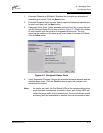
6 – Managing Ports
Configuring Ports
6-14 59048-04 Rev. B
D
6.2.5
Changing Port Symbolic Name
To change the symbolic name of a port from the faceplate display, do the
following:
1. Open the faceplate display and select a port.
2. Open the Port menu and select Port Symbolic Name.
3. In the Port Symbolic Name dialog, choose one of the following:
Enter a new name for the port in the Set Port Symbolic Name field.
Check the Restore Default Port Symbolic Name check box to restore
the default name.
4. Click the OK button.
6.2.6
I/O Stream Guard
The I/O Stream Guard feature suppresses the generation of Registered State
Change Notification (RSCN) messages on a port basis. I/O Stream Guard should
be enabled only on ports connected to initiator devices. To suppress the
generation of RSCN messages for the selected port, open the Port menu, and
click Enable radio button in the I/O Stream Guard area of the Port Properties
dialog.
6.2.7
Scan Device
The Device Scan feature queries the connected device during login for FC-4
descriptor information. Disable this parameter only if the scan creates a conflict
with the connected device.
6.2.8
Extending Port Credits
Each port is supported by a data buffer with a 16 credit capacity; that is, 16
maximum sized frames. For fiber optic cables, this enables full bandwidth service
over a distance of 26 kilometers at 1 Gbps (0.6 credits/Km), or 13 kilometers at 2
Gbps (1.2 credits/Km). Longer distances can be spanned at full bandwidth by
borrowing credits from designated donor ports thus pooling the buffer capacities.
This is called credit extension. Each donor port contributes 15 credits to the pool
from which the recipient ports can draw. For example, one donor port contributes
15 credits to the pool from which a recipient draws for a total of 31 credits (15+16).
This provides approximately 52 Km at 1 Gbps (31÷0.6) or 26 Km at 2 Gbps
(31÷1.2).
To extend credits, open the Wizards menu and select Ext Credit Wizard. The
Extended Credit Wizard leads you through the following process to extend credits
based on transmission distance requirements:


















